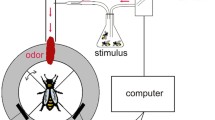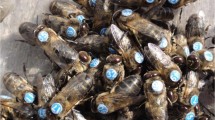Abstract
The effect of experience on the behavior of worker bees has been extensively investigated; however, few such studies have been conducted on male bees. Honeybee (Apis mellifera) males (drones), unlike the males of other social hymenopterans, return to their nest after performing a mating flight and have, therefore, an opportunity to learn from their experiences. This provides a chance to understand the significance of experience in social hymenopteran males. Here, we investigated whether experience improves the returning performance in drones (rate and time of return to the hive). We compared the returning performance of “Experienced” drones that were allowed to fly freely and thus had an opportunity to learn the position of the hive before the experiment with “Naive” drones that were not allowed to fly and therefore, had no opportunity to learn. We found that Experienced drones returned to the hive after a displacement, whereas Naive drones did not. Furthermore, time to return decreased with the age of drones. These results suggest that flight experience improves the returning performance, which should increase the possibility of mating success and overall colony fitness.




Similar content being viewed by others
References
Baer B (2005) Sexual selection in Apis bees. Apidologie 36:187–200
Becker L (1958) Untersuchungen uber das Heimfindevermögen der Bienen. Zeitschrift für Vergleichende Physiol 41:1–25
Benatar ST, Cobey S, Smith BH (1995) Selection on a haploid genotype for discrimination learning performance: correlation between drone honey bees (Apis mellifera) and their worker progeny (hymenoptera: Apidae). J Insect Behav 8:637–652
Bitterman ME, Menzel R, Fietz A, Schäfer S (1983) Classical conditioning of proboscis extension in honeybees (Apis mellifera). J Comp Psychol 97:107–119
Brandon JG, Coss RG (1982) Rapid dendritic spine stem shortening during one-trial learning: the honeybee’s first orientation flight. Brain Res 252:51–61
Capaldi EA, Dyer FC (1999) The role of orientation flights on homing performance in honeybees. J Exp Biol 202:1655–1666
Capaldi EA, Smith AD, Osborne JL, Fahrbach SE, Farris SM, Reynolds DR, Edwards AS, Martin A, Robinson GE, Poppy GM, Riley JR (2000) Ontogeny of orientation flight in the honeybee revealed by harmonic radar. Nature 403:537–540
Degen J, Kirbach A, Reiter L, Manz G, Greggers U, Menzel R (2016) Honeybees learn landscape features during report honeybees learn landscape features during exploratory orientation flights. Curr Biol 26:2800–2804
Dukas R (2004) Evolutionary biology of animal cognition. Annu Rev Ecol Evol Syst 35:347–374
Dukas R (2013) Effects of learning on evolution: robustness, innovation and speciation. Anim Behav 85:1023–1030
Durst C, Eichmüller S, Menzel R (1994) Development and experience lead to increased volume of subcompartments of the honeybee mushroom body. Behav Neural Biol 62:259–263
Dyer FC, Dickinson JA (1994) Development of sun compensation by honeybees : how partially experienced bees estimate the sun’s course. Proc Natl Acad Sci U S A 91:4471–4474
Fahrbach SE, Giray T, Farris SM, Robinson GE (1997) Expansion of the neuropil of the mushroom bodies in male honey bees is coincident with initiation of flight. Neurosci Lett 236:135–138
Galindo-Cardona A, Monmany AC, Diaz G, Giray T (2015) A landscape analysis to understand orientation of honey bee (hymenoptera: Apidae) drones in Puerto Rico. Environ Entomol 44:1139–1148
Gould JL, Gould C (1988) The honey bee. Scientific American Library, New York
Goulson D (2003) Bumblebees: their behaviour and ecology. Oxford University Press, New York
Hölldobler B, Wilson EO (1990) The ants. Harvard University Press, Cambridge
Howell DE, Usinger RL (1933) Observations on the flight and length of life of drone bees. Ann Entomol Soc Am 26:239–246
Jaffé R, Moritz RFA (2010) Mating flights select for symmetry in honeybee drones (Apis mellifera). Naturwissenschaften 97:337–343
Koeniger N, Koeniger G, Gries M, Tingek S (2005) Drone competition at drone congregation areas in four Apis species. Apidologie 36:211–221
Meinertzhagen IA (2001) Plasticity in the insect nervous system. Adv In Insect Phys 28:84–167
Menzel R, Brandt R, Gumbert A, Komischke B, Kunze J (2000) Two spatial memories for honeybee navigation. Proc R Soc B Biol Sci 267:961–968
Menzel R, De Marco RJ, Greggers U (2006) Spatial memory, navigation and dance behaviour in Apis mellifera. J Comp Physiol A 192:889–903
Menzel R, Greggers U, Smith A, Berger S, Brandt R, Brunke S, Bundrock G, Hülse S, Plümpe T, Schaupp F, Schüttler E, Stach S, Stindt J, Stollhoff N, Watzl S (2005) Honey bees navigate according to a map-like spatial memory. Proc Natl Acad Sci U S A 102:3040–3045
Menzel R, Müller U (1996) Learning and memory in honeybees: from behavior to neural substrates. Annu Rev Neurosci 19:379–404
O’Donnell S, Beshers SN (2004) The role of male disease susceptibility in the evolution of haplodiploid insect societies. Proc R Soc B Biol Sci 271:979–983
Oertel E (1956) Observations on the flight of drone honey bees. Ann Entomol Soc Am 49:497–500
Page REJ, Metcalf RA (1984) A population investment sex ratio for the honey bee (Apis mellifera L.) Am Nat 124:680–702
Richter MR, Waddington KD (1993) Past foraging experience influences honey bee dance behaviour. Anim Behav 46:123–128
Rueppell O, Page REJ, Fondrk MK (2006) Male behavioural maturation rate responds to selection on pollen hoarding in honeybees. Anim Behav 71:227–234
Ruttner F (1966) The life and flight activity of drones. Bee World 47:93–100
Shettleworth SJ (2001) Animal cognition and animal behaviour. Anim Behav 61:277–286
Winston ML (1987) The biology of the honey bee. Harvard University Press, Cambridge
Witherell PC (1971) Duration of flight and of interflight time of drone honey bees, Apis mellifera. Ann Entomol Soc Am 64:609–612
Withers GS, Fahrbach SE, Robinson GE (1993) Selective neuroanatomical plasticity and division of labour in the honeybee. Nature 364:238–240
Wolf S, Chittka L (2016) Male bumblebees, Bombus terrestris, perform equally well as workers in a serial colour-learning task. Anim Behav 111:147–155
Acknowledgements
We thank Emeritus Prof. Yasuhisa Kunimi, Dr. Madoka Nakai, and Dr. Maki Inoue, Faculty of Agriculture, Tokyo University of Agriculture and Technology, for providing helpful comments and suggestions for this study.
Author information
Authors and Affiliations
Corresponding author
Rights and permissions
About this article
Cite this article
Hayashi, S., Farkhary, S.I., Takata, M. et al. Return of Drones: Flight Experience Improves Returning Performance in Honeybee Drones. J Insect Behav 30, 237–246 (2017). https://doi.org/10.1007/s10905-017-9616-2
Revised:
Accepted:
Published:
Issue Date:
DOI: https://doi.org/10.1007/s10905-017-9616-2




